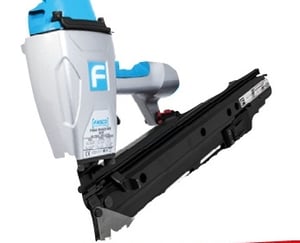
Pneumatic tools are power tools that utilize compressed air to drive fasteners with force and momentum instead of electric powered motors. This central feature provides a wide range of benefits for fastening. Ultimately, using pneumatic tools on a site not only provides a great deal of efficiency but also ensures higher quality fastening which is more durable and longer lasting. All of this translates into significant savings on labor costs in a market that is facing a heavy labor shortage. Here's what you need to know about superior fastening with pneumatic tools.
Increased Speed and Efficiency
Using pneumatic tools drastically reduces the amount of time spent driving in fasteners, especially when using combination fasteners that utilize the speed of driving in a nail as well as the holding power of a screw. SCRAIL® fasteners, driven in by pneumatic tools, can be driven in with twice the speed of collated screws, and eight times faster than regular bulk screws. Considering the amount of fastening required at a job site, using pneumatic tools can save a great deal of time and money.
As they do not require a large battery or heavy motor, pneumatic tools are often much lighter than their electric counterparts and do not heat up. This makes it more comfortable for the operator, allowing them to work faster.
Greater Durability and Longevity
Pneumatic tools have fewer moving parts than electric tools, and thus can end up lasting longer than electric tools. Modern pneumatic tools have long-lasting lifespans and require very little maintenance. The initial investment of an air compressor is easily offset by this aspect.
Pneumatic tools offer a greater punch in power when compared to electric tools of the same size and have an adjustable depth of drive. This means no improperly driven fasteners that compromise the durability of the build. Used in conjunction with combination fasteners such as a SCRAIL® fastener, the holding power of joins is also drastically higher. This again adds to the durability and longevity of a build done with pneumatic tools.
Improved Safety
Using electric power tools carries the risk of electrical shock, for example a cut in the power cord or water exposure. Furthermore, electric tools heat up from excessive use, which not only slows down the worker but also carries a risk of harm. Pneumatic tools are driven by the momentum and force of air pressure, eliminating the risk of electrocution and overheating.
Maximize Performance with Optimal Pressure and Flow
The paradigm with electric tools is that more power is more force and therefore better performance. In contrast to this, less is more with pneumatic tools when it comes to optimizing the life of the tools and increasing the quality of the project. It's crucial to run the compressor at the recommended PSI for the tool you are using. Most tools will require 90 PSI and using excessive pressure will burden the tool components and accessories. Over-pressured tools will also under-perform and can cause damage to the surrounding wood. On the other hand, you must ensure the compressor you are using can keep up with the air-flow rate (CFM) requirements of all the tools being used at your job site. The more compressed air you have flowing, the more tools you can run simultaneously.
Trust BECK with Your Fastening Needs
Going pneumatic provides a plethora of benefits for contractors when used for the right jobs. Take your fastening to the next level by increasing the speed, efficiency, durability, longevity, and safety of construction jobs. Download our whitepaper, "Benefits of Pneumatic vs. Traditional Tools" to learn more about how pneumatic tools can save you man-hours and cost while increasing the overall quality of workmanship.
.svg.png)

